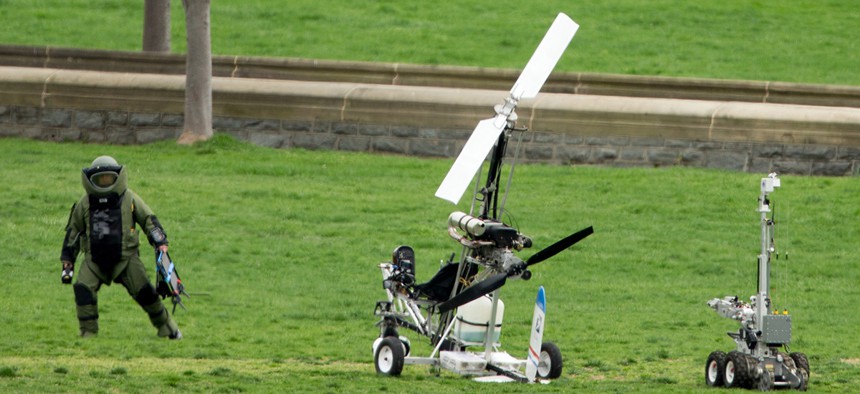
A member of a bomb squad approaches the gyrocopter after it landed in April. Andrew Harnik/AP
Officials: Gyrocopter Didn't Look Like a Threat on Radar
No alert went out before Doug Hughes landed just west of the Capitol.
After two weeks of closed-door briefings and mounting questions on how a postal worker from Florida was able to land his gyrocopter on the Capitol's west front unharmed, lawmakers finally got the public chance to unload their frustrations on a coterie of top law enforcement and airspace security officials Wednesday.
The House Oversight and Government Reform Committee hearing was meant to unweave the tangle of law enforcement agencies that police the Capitol Hill sky—and figure out who knew what and when about 61-year-old Doug Hughes' brief mission.
Through their exchanges—and sometimes raised voices—lawmakers and witnesses painted a picture of what happened on April 15: Security agencies didn't know Hughes was on his way. Radar didn't indicate the object moving through the air was a gyrocopter (since it doesn't have the capability to distinguish a gyrocopter or a drone from a bird or terrain). Police first trained their guns on Hughes only as he landed.
"We have gotten to the point where I am worried about the president. I'm worried about his family. I'm worried about the security here on the grounds here at the Capitol. I'm worried about the Supreme Court across the street," Rep. Stephen Lynch said. He then asked if there was anything that's been done in the past two weeks that would yield a different result if someone with nefarious intent pulled a similar stunt. The room was silent.
A few minutes later, Committee ranking member Elijah Cummings said: "The gentleman just asked a question, and the silence was chilling. He asked a question. ... I do need to know a yes or no, have we done things now that put us in a better position than where we were on the day of this events. And I don't want silence. It's not good enough."
The assembled officials said yes, but they would need to brief members in a closed-door session. Additionally, they said technology is being tested that could help address how a gyrocopter can't be seen on a radar screen.
Multiple players were seated at the table to answer the committee's questions: the Secret Service and the Federal Aviation Administration heads, the Park Police and the Capitol Police chiefs, the House Sergeant at Arms, the commander of NORAD and a Department of Defense official. The witness list alone illustrates the wide and complicated web of jurisdiction governing the skies over the Capitol.
In his own opening statement, Committee Chairman Jason Chaffetz blasted the agency heads for giving "bland" opening testimonies, saying they didn't share anything except a timeline and that he didn't learn much.
Cummings said the threats against the nation are ever-evolving in their complexities. "The last thing we want to do is give a roadmap to those who want to harm us," the Maryland Democrat said. "I hope that you all agree on that." His voice rose as he implored the witnesses to advance their technological capabilities.
Chaffetz and Cummings quizzed Dine multiple times to gain clarity on whether Capitol Police could have shot the gyrocopter out of the air. Guns were trained on Hughes "as he landed," Dine answered, saying officers first saw Hughes' gyrocopter when it was seconds from reaching the Capitol.
What happened next—officers arrested Hughes, rather than shooting him—required officers to weigh various factors: How quickly the gyrocopter landed, its proximity to the Capitol, Hughes' compliance and the ramifications of use of force.
"All of those decisions are processed literally in a matter of seconds," Dine said, calling Capitol Police's actions in this case "heroic."
Messages to the entire congressional community weren't sent as the incident was unfolding (though Capitol Police notified the Senate community, but not the House, said Paul Irving, the House Sergeant At Arms). "I have ordered the chief never to allow this to happen again," he said in his opening statement.
Notifications to the House should have gone out, Irving said, but there was a mix up it the command center, and he assured the committee it would not happen again. Dine said the message system was overly complex, but it has since been fixed.
At times, the hearing became heated, particularly when lawmakers questioned officials for not knowing Hughes was in the air from other cues (such as social media and his livestream).
"Is Twitter, like, a new thing for you?" Chaffetz asked. "I mean, this stuff is out there. Try Google alerts. It's there. If it's not showing up on the radar, it was showing up on the media's radar."
Rep. Mark Meadows charged the witnesses with meeting beforehand and having a "coordinated effort to be a stone wall." Those at the table acknowledged they had held a meeting Tuesday, but said it was only to determine what should be said openly and what needed to be left for a closed briefing with the committee.
In their opening statements, several witnesses took the committee through the day's timeline:
Capitol Police Command Center personnel were still attempting to validate calls and emails from a Tampa Bay Times reporter about a man flying through restricted airspace when Hughes landed on the West Front Lawn.
The time was 1:23 p.m. on April 15. Two minutes prior, a reporter asked an officer posted at the Pennsylvania Avenue walkway at the West Front if he had seen a helicopter flying around the area. He hadn't, but asked another officer. And during this discussion, the two spotted the gyrocopter over Union Square, the public plaza that includes the Capitol Reflecting Pool.
They reported the landing, and the information was broadcast over the radio. By 1:24 p.m., the Federal Aviation Administration was aware of the incident and was looping in other interagency partners on a 24/7 communications line.
"On April l5, this gyrocopter did not register on radar as a threat and, therefore, was not raised as a concern among our federal partners," Capitol Police Chief Kim Dine said Wednesday at a House Oversight and Government Reform Committee hearing on the gyrocopter incident.
Hughes' gyrocopter had appeared on the FAA's radar screen. But as a small, unidentified element. "All available information about the slow moving, irregular symbol made it indistinguishable from other non-aircraft radar tracks," Michael Huerta, FAA administrator, said at the hearing.
Because a lockdown was quickly lifted — Hughes was arrested without incident, K-9 dogs hadn't detected anything on Hughes and his intent was clearly shown in his videos — no messages were sent to the congressional community making them abreast of the situation, Dine said.
Ultimately, though, incidents like the gyrocopter send the wrong signal, Chaffetz said in his closing statement. "Every time we have an incursion, and they're not taken down fast and hard, some other nut job is going to get an idea," Chaffetz said. "And terrorists are going to get more ideas. Figure it out!"
NEXT STORY: Who Won and Who Lost in the Budget Deal?







